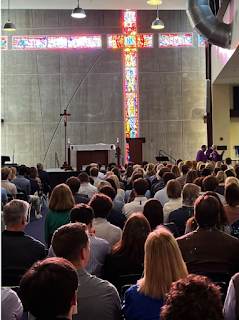Looking for the Light
In the days leading up to their annual school Christmas program, my kids dutifully informed me that no flash photography was allowed during the event. So I carefully considered which camera lens and settings would make the best use of the available light in the church. On the day of the program, I arrived early to get a good seat, set my camera, and take some satisfactory test shots in the well-lit sanctuary.
Right before the program began though, most of the lights in the church were dimmed, leaving only the area around the altar illuminated. I quickly adjusted my camera settings to try to accommodate the drastic change in light, just as my 10-year-old son narrated the opening line of the program: “The soul of Israel cries out, ‘Please, God, send us a savior.’”
Despite the unexpected challenge in documenting the moment, the illusion of darkness was a fitting backdrop to depict Israel’s longing for a savior. In today’s reading from the prologue of John’s Gospel, John alludes to the opening creation narrative from the Book of Genesis, when light itself had yet to be created, to emphasize the darkness that permeated human history prior to the arrival of the Word made flesh. God’s people were unable to see past their long history of turning away from God. John recounts how God’s response was to send his Son to become one of them and dwell among them, to reveal the Father to them and thereby show them how to live in right relationship with God and one another. The Son of God thus became the “light of the human race,” bringing grace and truth to those who accepted him.
The enduring reality of the Word becoming flesh is that God is still present with his people. To be a Christian on this side of salvation history is to live in the tension of the already-but-not-yet: our Savior has already come, but we still await his second coming and the ultimate completion of God’s plan of redemption. We therefore still live in a fallen world, and know all too well the brokenness and pain that intersect with our human experience. But by choosing to fully enter into our humanity, God provided a way to truly meet us in the sufferings that we endure. John’s conviction that “the light shines in the darkness, and the darkness has not overcome it” challenges us to recognize the presence of God illuminating our lives, and to cling to the belief that God is always greater than the darkness that we face.
Pope Francis expresses a similar assurance in his encyclical letter, Lumen Fidei (The Light of Faith):
"Faith is not a light which scatters all our darkness, but a lamp which guides our steps in the night and suffices for the journey. To those who suffer, God does not provide arguments which explain everything; rather, his response is that of an accompanying presence, a history of goodness which touches every story of suffering and opens up a ray of light. In Christ, God himself wishes to share this path with us and to offer us his gaze so that we might see the light within it."
Pope Francis’ words reveal connections to the Ignatian principle of “finding God in all things.” Ignatius’ entire approach to spirituality is in fact possible precisely because God became one of us and remains with us in our everyday lives. And so as we as a Jesuit community continue to grow in our understanding and practice of Ignatian spirituality, I recognize a call to train ourselves to look for the light— to regularly pause to reflect on the ways that God has been active in our lives, to be more open to seeing God in the midst of our daily encounters, and to trust that his presence will continue to guide us.
Author: Danielle Bianchi, Theology Department



Comments
Post a Comment